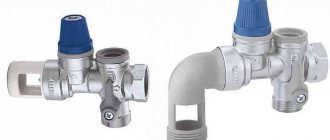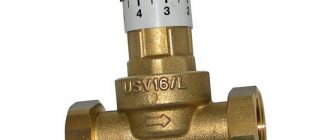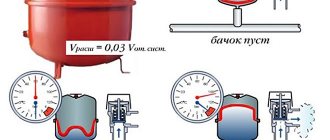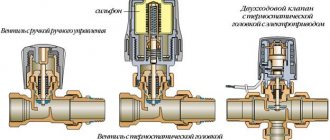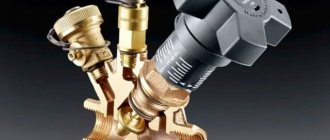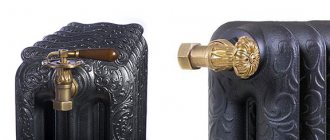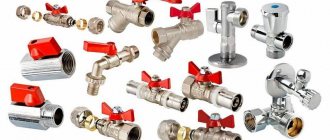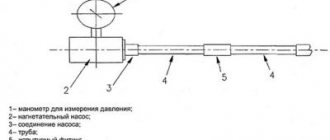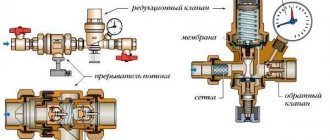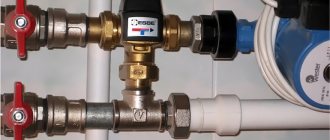Safety valves are necessary to relieve excess pressure in vessels, boilers, pipelines, heating systems, etc.
There are several types of safety valves differing in their operating principle. This information will not provide a comprehensive answer on how to choose a safety valve. To select a fuse, it is necessary to take into account not the operating principle, but many other characteristics: pressure, diameter, medium temperature, throughput, etc.
According to data from the book Calculation and design of pipeline fittings, the valve operation process can be divided into 5 stages:
- The first stage – the pressure is normal.
The pressure in the object and in the valve is equal to the working pressure, while the valve is closed tightly. - The second stage – the pressure increases
The pressure increases to Value P=K0P0, where K0 is the valve overload coefficient; P0 is the nominal (initial) pressure in the installation. In this case, the force in the spring is equal to the force from the medium pressure. Due to the disappearance of the force interaction between the sealing rings, intense leakage of the medium occurs in the absence of visible movement of the valve disc. - The third stage - pressure increase.
The pressure of the medium increases above K0P0, the valve plate rises above the seat and the passage of excess medium begins. As the pressure increases, the valve disc moves upward and the flow rate increases. - The fourth stage is pressure relief.
With the release, the pressure in the object decreases and reaches a value at which the valve disc seats on the seat. This pressure is usually lower than the pressure at which the poppet begins to rise and depends on the design of the relief valve. The valve plate sits on the seat; as the pressure decreases, the tightness of the valve lock increases and the leakage of the medium decreases. - Fifth stage - closing the valve
When the operating pressure is reached, the valve closes tightly and the leakage of the medium decreases.
How spring safety valves work
In spring-loaded valves, the pressure of the medium on the valve is opposed by the degree of compression of the spring. It is this that determines the actuation force, and the range of adjustments depends on the elasticity of the spring used.
The coolant exerts pressure on the spring, which compresses. When the set pressure is exceeded, the spool rises and the coolant is discharged through the outlet pipe. After the pressure in the system has dropped to the set pressure, the valve closes and the coolant drainage stops.
The response pressure of the spring safety valve is set by equipping the valve with various springs.
Many valves are manufactured with a special mechanism (lever, fungus, etc.) for manual detonation for control purging of the valve. This is done in order to check the functionality of the valve, since various problems may arise during operation, such as sticking or freezing of the spool to the seat.
Valve without manual release
Select valve
Manual release valve
With manual detonation
However, in industries using aggressive and toxic environments, high temperatures and pressures, control blowing can be very dangerous. Therefore, for spring valves used in such industries, the possibility of manual blowing is not provided and is even prohibited.
Video of the operation of a spring safety valve from the StroyNefteGaz channel
The spring safety valve is available in three versions:
- Low-lift devices are suitable for gas and steam pipeline systems, the pressure in which does not exceed 0.6 MPa. The lifting height of such a valve does not reach more than 1/20 of the seat diameter
- Medium-lift devices in which the spool lift height is from 1/6 to 1/10 of the nozzle diameter.
- Full-lift devices in which the valve lift height reaches up to ¼ of the seat diameter.
valves
For steam boilers
- For steam boilers
- For hot water
-16%
Compare
Close
Valves T-31MS Du50
RUB 50,000.00 RUB 42,000.00
The T-31MS Du50 safety valve is used in the industrial sector, heat power engineering and public utilities to protect steam pipelines and boilers in general from damage and ruptures due to exceeding the operating pressure of the environment. Developed by the TKZ plant to complete steam boilers.
Add to favorites
Add to order
Quick view
-19%
Compare
Close
Valves T-131MS Du50
RUB 58,000.00 RUB 47,000.00
Spring safety valve T-131MS Du50 is designed to protect equipment and pipelines from unacceptable pressure increases by releasing excess working fluid. Developed by the TKZ plant to complete steam boilers.
Add to favorites
Add to order
Quick view
-13%
Compare
Close
Valves T-32MS Du80
RUB 57,000.00 RUB 49,800.00
The T-32MS safety valve is used to prevent damage and destruction of elements of technical systems by releasing excess medium pressure in the pipeline. Developed by the TKZ plant to complete steam boilers.
Add to favorites
Add to order
Quick view
Load previous products
Load the following products
Types of valves and their operating principle
Any modification of safety valves in a heating system includes a shut-off element and a force mechanism. Based on their design features, there are several types of fuses.
Separately classified are valves for relieving thermal potential with a bellows, a heat-sensitive liquid that compensates for load differences. There are models that include a safety group in the form of a blast valve with a part responsible for venting air and a pressure gauge.
The non-return relief valve for heating designs can be spring or gravity. Due to the built-in mechanisms, the contactor is kept closed, which ensures the flow of coolant in one direction.
Closures can be double-leaf, petal, disk, pressed against a saddle, bushing, or other main base. It is necessary to obtain a hermetically sealed seal.
Inside view
The principle of operation of the fuse lies in the fact that in the normal state, the membrane layer fixed between the rod and the spring fits tightly to the seat, hermetically blocking the outlet. When the coolant boils, expansion of the liquid is observed, the load inside the system rises, but is partially regulated by the expander.
At the maximum permissible load level, the spring is strongly compressed, releasing the membrane, which immediately opens the passage.
The lid rises, releasing as much hot steam as is required to stabilize the operation of the equipment.
When operation returns to normal, the spring returns to its original position, the membrane seals the release hole, and the lid returns to its place.
If the owner is near the devices, you can perform an emergency reset yourself by turning the top handle.
By pressing method
When heating a private house, apartment or industrial premises where low-power equipment is used, a spring emergency relief valve for the heating system is often chosen.
These are simple, compact, inexpensive, but reliable models that can be combined with other equipment for safety.
The compression ratio of the spring is related to the load parameter at which the valve is activated. The elasticity of the spring affects the range of settings.
The principle of operation of the device: a water flow exerts pressure on the shutter, as it increases, the degree of compression of the spring greatly increases. This causes the spool rod to rise upward, releasing excess steam, and the in-pipe volume of liquid is stabilized. Meanwhile, the spring returns the unit to its original state.
Spring modifications are made from high-strength brass using hot stamping technology. The spring itself is steel, and the membrane, seals, and handle are polymer.
You can choose models with factory settings or those that need to be configured individually during installation.
Lever fuse
Lever-weight safeties are used less frequently, since raising the rod provides an external suspended weight that moves along the entire lever, adjusting the degree of pressing of the rod to the seat.
By the degree of shutter lift
Low-lift valves require the valve to be raised by no more than 0.05 from the diameter of the seat: the opening mechanism is completely proportional.
The product is characterized by low throughput and primitive design. The fuse is installed in installations with liquid media.
Full lift modification
Full lift variations promote the maximum permissible level of valve lift, which improves throughput as a large amount of steam is released at a time.
By response speed
The proportional emergency valve for urgently relieving excess water pressure in the heating system assumes that the valve rises gradually, according to the degree of internal load. As the damper rises, the volume of steam released gradually increases. Such installations can be used with any type of boiler, but most often they are installed in systems with water or other liquid.
On-off valves operate instantly, opening fully when pressure rises. It is recommended to install such devices in a compressible environment. The main disadvantage of the safety element is the presence of self-oscillations of the bolt.
Two-position valve
Installation of on-off valves must be carried out taking into account the release of a large amount of water when opening suddenly. This results in a very rapid release of pressure, closing of the valve, and as a result - a water hammer, which is absent in proportional fuses.
You can learn more about the design of the valve and the principle of its operation in the following video:
Magnetic spring safety valves
Magnetic spring safety valves use an electromagnetic actuator. The electromagnet provides additional pressing of the spool to the seat.
When the response pressure is reached, the electromagnet turns off and only the spring counteracts the pressure, and the valve begins to operate like a regular spring valve. Also, the electromagnet can create an opening force, that is, counteract the spring and force the valve to open.
There are valves in which the electromagnetic drive provides both additional pressing and opening force; in this case, the spring serves as a safety net in case of power failure.
Magnetic spring valves are typically used in complex impulse safety devices as control or impulse valves.
